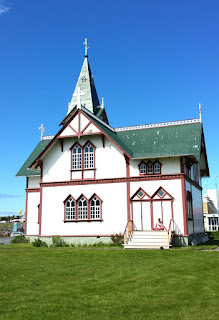Dolphins count as Whales, Puffins, Elf Queens & Hairy Houses
Happy 4th of July to all of you. We are back home safe and sound, but still have just a few more photos to share.
Driving on from Akureyri, we ventured north to the hamlet of Husavik, once whaling capital of Iceland. Fortunately, whale hunting has diminished significantly, though still offered on some menus.
On a relatively fair day, we boarded a sailing ship to venture out on the current tourist draw of puffin and whale watching. After donning insulated flotation suits worthy of a North Sea oil rig workers, the ship motored out into the fjord. We saw a bazillion puffins flitting around and feeding near a small uninhabited island - Puffin Island-go figure, but could not approach too close due to the draft of the boat. Then with the wind from the stern and my favorite (NOT) a "following sea" attempted to spot some whales - minkes, humpbacks, blues - on the far side of the fjord.
We did see a number of white striped dolphin leaping and flipping around us, which was quite fun. This type of dolphin often have a lifespan of 50-60 years, gestate for 365 days, measure about 8 feet in length and weigh 350 lbs. But alas, no actual whales showed themselves during our sail. However, the crew made a point of declaring our outing as a - "success" by categorizing dolphin as "whales"- probably for the purpose of maintaining their 98% success rate at whale-spotting on their advertising.
Neat as a pin Husavik church, with knitter on the back steps enjoying sunshine
Whale skeletons (obtained from beached/stranded whales) in the Husavik Whale Museum. Near to far are skeletons from: an Orca, a Cuvier-beaked whale, and a Long-finned pilot whale.
A skeleton from a rare Sowerby beaked whale
A model pair of the now extinct Great Auk. The last known living pair were killed in Iceland in the mid-1800s at the behest of a collector.
After our unsuccessful whale sail in Husavik, we made a special trip to a remote area of the Eastern Fjords, called the Borgarfjordur Eystri to see a large colony of Atlantic puffins. Relatives of the auks, puffins are pelagic seabirds (of 3 subspecies) which sport colorful beaks and orange feet during mating season. Due to their relatively heavy body and stubby wings, the puffins must flap up to 400 times per minute to maintain flight back and forth from the water to the nest. Puffins normally nest by burrowing in steep hillsides or sea cliffs and can be quite difficult to see up close without risking one's human neck. We traveled to this remote spot specifically because a set of steps and platforms had been built up alongside the cliff in several places to enable visitors to see the birds from only a few feet away, without risking life and limb. Delightful!
As we left that area on our way to Seydisfjordur, our evening stop, we learned that the area is also the location of Alfaborg, the City of Elves, and residence of the Icelandic Elf-Queen, Borghildur. Those gifted with "second sight" are able to see the elves or hidden people, as they are often called. The elf homes are thought to be inside the rocks, such as the mound to the left of this sign, and are similar to those of 19th century Iceland, only "nicer".
Apparently, it's not uncommon in Iceland to divert road construction or alter building projects if thought to be in an area that might disturb the indigenous community of elves.
We had to cross a snowy pass (in June!!!) to overnight in Seydisfjordur, a very picturesque town located at the apex of a fjord.
One of a multitude of waterfalls above Seydisfjordur.
The pretty little "Blue Church" of Seydisfjordur, an eastern fjord town.
Now, we'll be completing our travels along the Ring Road by heading south and westward along the coast back to Reykjavik.
Enjoy,
Barbara and Paul










No comments:
Post a Comment